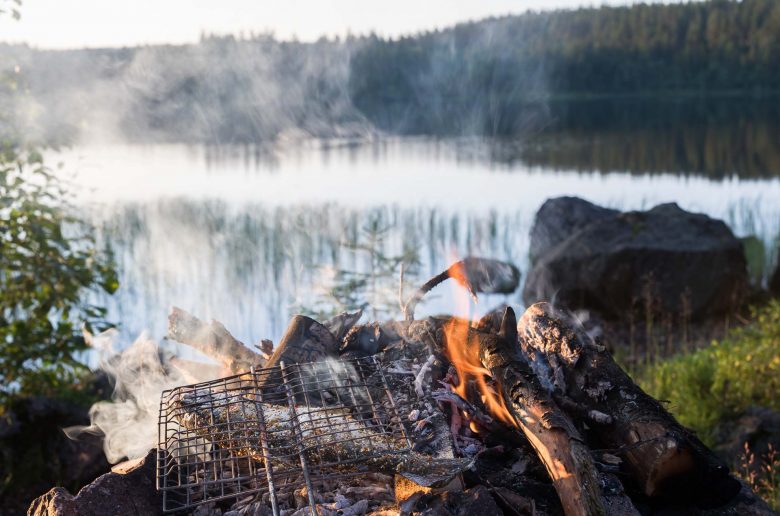Salmo trutta (nor.: ørret; swe.: öring; fin.: taimen; dt.: Forelle)
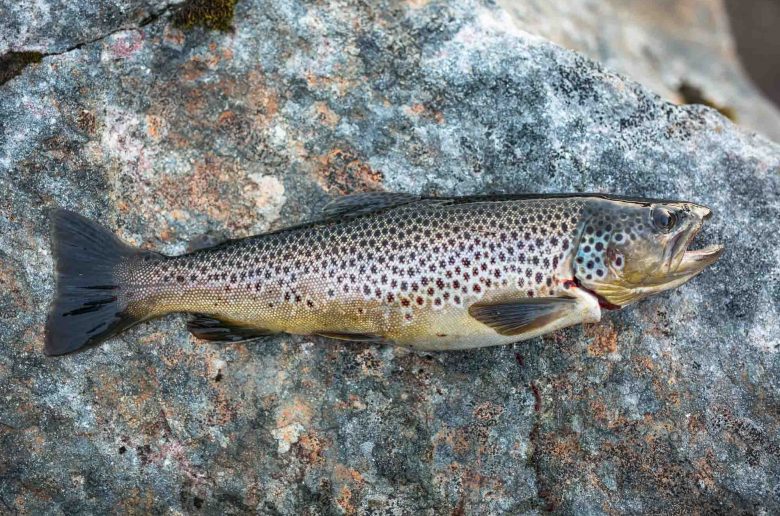
Trouts are among the most popular fish throughout the whole Scandinavia. They have adapted to many habitats and while some are dwelling freshwater rivers (brown trout), others have become lake-locked (lake trout) or even migratory (sea trout). They are all the same species of fish with different habits and habitats which can have a sever effect in their optical appearance and size. Usually ‘trout’ or the respective local term refers to the form of brown trout.
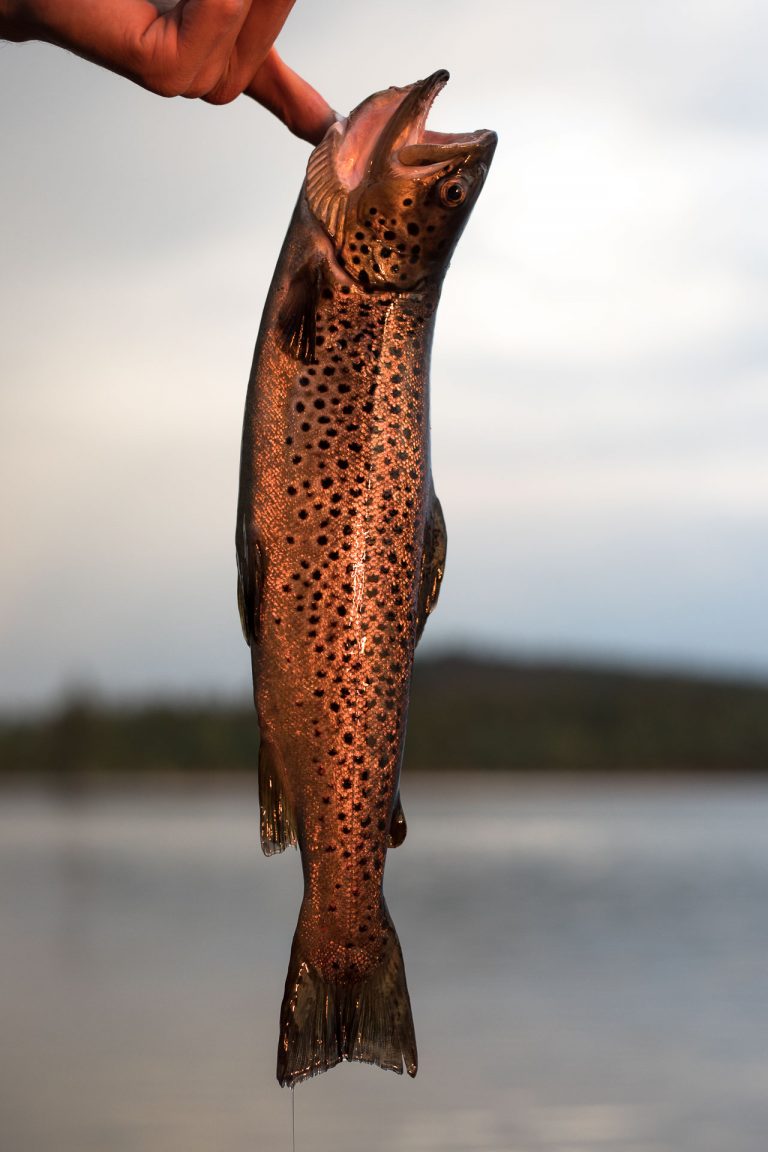
Fishing & Fishing Methods
This is THE fish for many anglers, powerful, hard fighting and torpedoing out of the water. In their wild form brown trout is mostly at home far North in Lapland. In other parts all over Scandinavia they are stocked in popular fishing rivers for sport fishing purposes. The distinguishing feature between a native brown trout and a stock is usually the adipose fin (second smaller torsal fin) that is clipped in the cultivated forms. Except for Lapland (respective under 64° North in FInland) fish with adipose fin must be released and regulations are very strict on that.
The best fishing season depends a bit on your fishery of choice. For river fishing April and May are usually good months when the stoneflies hatch. Later in summer you might wander the night hours (there are not much dark hours in the North) for best results. They are mainly caught by lure- or fly-fishing and you might have to adapt your strategy from place to place. If you opt for spin fishing, the color red works usually quite well for wobbler, spinner or spoons.
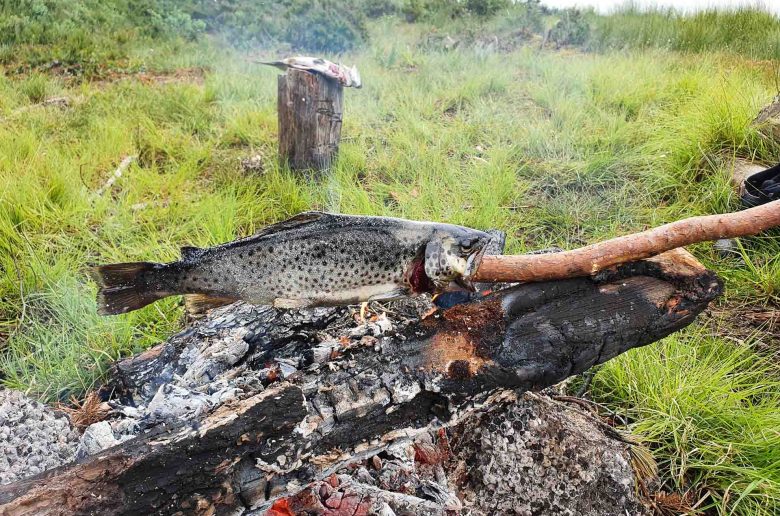
Spinning
- Wobbler small (0-10 cm)
- Wobbler between (11-20 cm)
- Spinners (0 – 5 grams)
- Spinners (6 to 12 grams)
- Spinners (over 12 grams)
- Spoons (big)
Fly Fishing
- Tub fly
- Dry Fly
- Nymphs
- Gold head Nymphs
- Stremers
- Wetflies
Angling
- Maggot (winter)
- Shrimp (often forbidden)
- Worm
- Live Fish (Ice Fishing)
- Dead Fish (Ice Fishing)
Trolling
- Wobbler small (0-10 cm)
- Wobbler between (11-20 cm)
Angling Record
- Finland: 10,42 kg
- Sweden: 15,3 kg (lake trout 17 kg)
- Norway: 15,3 kg
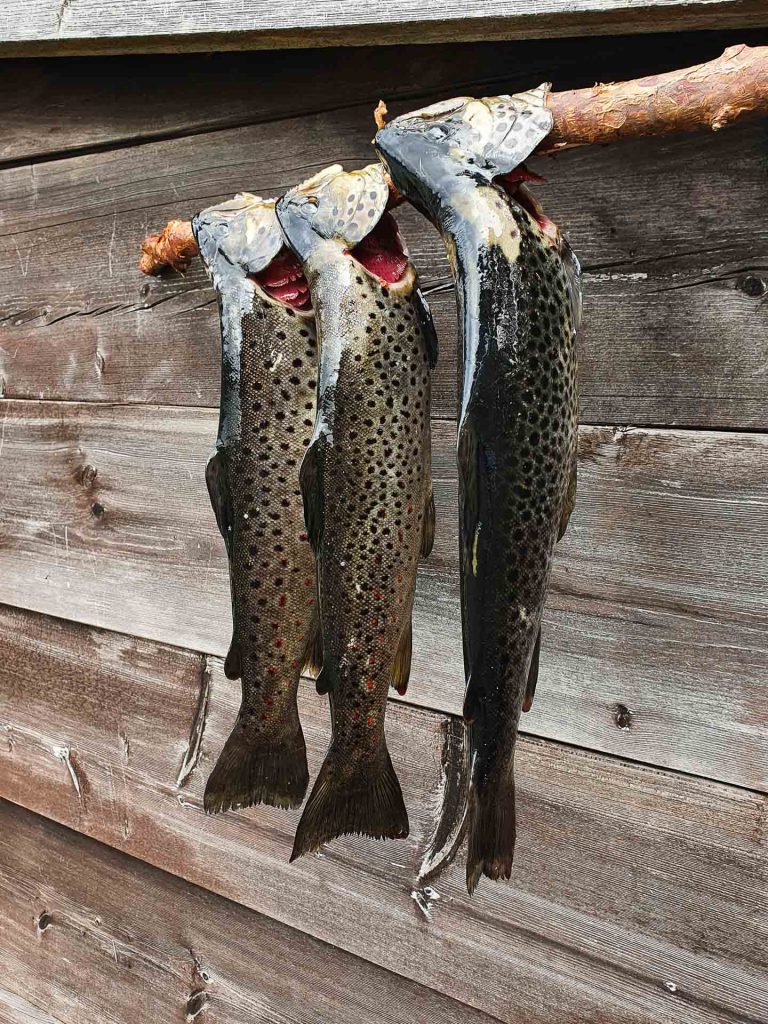
Appeareance
Trout and salmon resemble each other in many respects, and while there is still a great deal of variation in the appearance of both species, even a more experienced fisherman may have difficulty identifying the species (especially lake trout and sea trout). Spawning fish in particular are difficult to identify. Trouts usually have more spotting below the rib line and the stem of its tail is usually stout, tall and evenly thick. The tail fin of large trouts is almost straight, while the salmon tail usually has a clear notch. Salmon is usually brighter in color than trout and its scales are larger. The trout’s mouth is also slightly larger than the salmon, and the upper jaw extends behind the eye.
Trout are known for their various forms based on their habitat and migratory behavior – sea trout, lake trout and stream trout. However, ecological and genetic studies of trout have shown that the division of trout into different forms based solely on migratory behavior, habitat or growth rate is partly artificial – meaning that it is the same species with different behavior.
In addition you can also find rainbow trouts in the rivers and lakes of Scandinavia, especially Finland and Sweden. This is a different species of trout that was introduced to Scandinavian waters around 130 years ago. FInd further information on rainbow trouts in the respective section.
Distribution
The natural distribution of trout covers almost the whole of Europe. On other continents, trouts are found e.g. In the Caucasus, West Asia and in places in North Africa. The species was exported to North America from Europe in the 1880s. Trouts are found all over Finland, both in the sea and in inland waters. Migratory and local individuals can live in the same body of water, and different forms can multiply with each other if there are no barriers to migration.
Reproduction
All trout spawn in streams, but the so-called sea trout migrates to feed in the sea and the so-called lake trout into the lake. The actual brown trout basically lives its entire life in streams. In practice, however, the boundaries are not always clear and it is likely that some trouts live in small streams all their lives, while other may set off to a lake or sea below. That is why it is also difficult to keep stocks separate, especially in areas where spawning grounds for migratory and local trout are the same.
Sea Trouts leave the sea to spawn for the first time after 2-5 sea years and weigh about 1 kg. In lakes, female trouts also become sexually mature at a weight of about 1 kg. In Lapland, female trouts begin to breed at 1 to 2 kilograms and males at one kilogram. In streams, trout usually mature when they are 3-5 years old. Trout spawn in the spawning pits they dug in the bottom ditch of the watercourses between September and November. In fertilized eggs, the embryo develops inside the gravel during the winter and the young fish hatch in early spring with a length of almost 2 cm.
Feeding, growth and migration
Trout fry usually lives in the river for 2 to 5 years. At about 18 to 25 centimeters, they start theire migratory behavior, swarming and migrating to the sea or lake with the spring flood. Some of the young fish stay in the river for the rest of their lives. In the ocean, trout remain near the coast. The majority of tagged fish are caught within a hundred kilometers of the planting site.
Young trouts eat insects and larvae that travel with the stream or live on the bottom. During their migration to the ocean or lake, young trouts eat insects early and fish later. In the sea, the main food source is herring and other small fish, in the lakes e.g. mostly vendace. Trout living in streams mainly eat insects. Trout fry usually reach migratory size in 2-5 years. In the sea, trout growth is quite rapid, as they reach the two-kilo limit on average during the second sea year and five kilos in their fourth sea year.
Stock threats, management and endangerment
There have many trout stocks migrating to the sea throughout Scandinavia, but most of them have been destroyed or sharply reduced due to water conservancy, deteriorating water quality and overfishing. All stocks are highly endangered. The situation for lake trout stocks is similar. Originally they have been found in most of the large lakes in Scandinavia and Finland but nowadays most oft hem are endangered. Most of them are supported by stocking efforts. Native seedling populations living locally in small streams have also declined sharply in recent decades. The reasons have been e.g. ascension barriers, forest drainage, river and stream erosion, water pollution and fishing.
One requirement to restore the natural cycle requires that enough fish be allowed to return to spawning – this requires fishing arrangements as closed fishing seasons during some phases. In Finland and other areas of Scandinavia stocked trout for fishing purposes must be marked by a clipped adipose fin in order to separated them from the native trouts. Native trouts are usually protected in Southern and Central parts of Scandinavia and must usually be released. Depending not he area the undersize for wild trout is betwenn 50 and 60 cm depending on the area and fishery.
